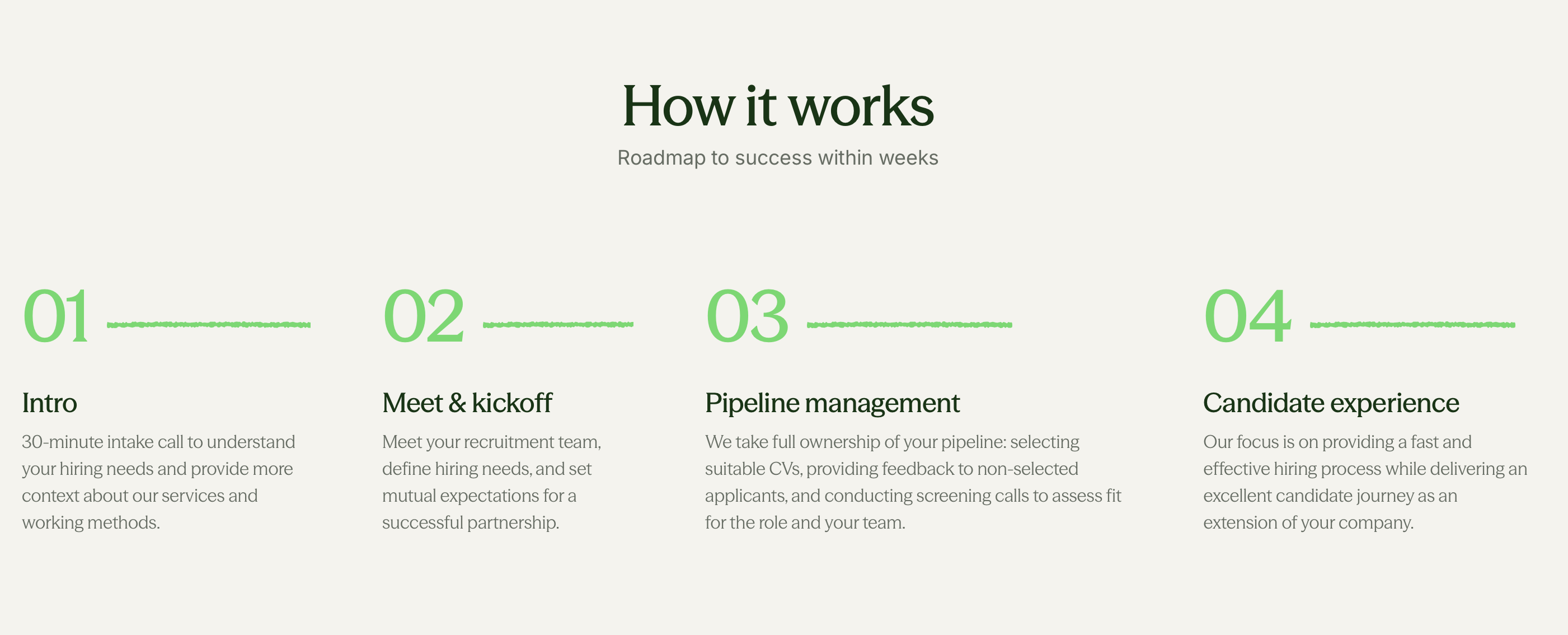If your company is growing, entering new markets, or hiring in waves, one question always appears: how do you scale hiring efficiently without slowing down the business or compromising candidate quality?
Many companies start with in-house hiring, bring in agencies or freelancers when they face capacity gaps and eventually reach a point where they need something more integrated and predictable. That is where Recruitment Process Outsourcing (RPO) becomes the most effective model.
RPO is no longer a solution for enterprise-level companies only. Startups and scale-ups now use it to stabilise hiring, improve candidate experience, and remove internal bottlenecks.
This article explains what RPO is, when companies choose it, and why it often becomes the most scalable recruitment strategy.
What RPO Actually Is
RPO is a recruitment model where a company outsources part or all of its hiring process to an external partner who operates like an extension of the internal team.
The biggest difference from agencies is how integrated the collaboration becomes. RPO recruiters use your tools, your processes, your tone of voice and represent your employer brand in the market.
RPO typically includes:
- Screening and qualification
- Pipeline ownership
- Candidate communication
- Coordinating hiring managers
- Interview scheduling
- Metrics and reporting
- Process optimisation
You keep control of hiring decisions.
Your RPO partner keeps the process fast, organised, consistent and candidate-friendly.
Why Companies Choose RPO Instead of Hiring Internally
1. In-house hiring becomes overloaded
In many growing companies, recruitment responsibilities sit with:
- HR teams who already manage multiple functions
- Managers who hire on top of their core responsibilities
- Talent teams who are stretched across too many roles
This leads to delays, slower time to hire and inconsistent updates for candidates.
RPO removes this bottleneck by taking full ownership of the operational side of hiring, while your team focuses on interviews and decisions.
2. Seasonal or rapid growth requires more structure
If you need to hire 10 people in one quarter and 2 in the next, keeping a large in-house team full time is not efficient.
RPO is scalable.
You can increase or decrease recruitment capacity depending on hiring volume without hiring more employees.
This is especially useful for:
- Product launches
- Market expansions
- New team builds
- Fundraising rounds
- Peak hiring seasons
3. You need predictability and clear costs
Agencies usually work on contingency fees that increase for every hire.
RPO uses a fixed monthly cost, which makes budgeting easier and prevents unexpected spending spikes.
It is cost-effective when:
- Hiring is consistent
- More than one role needs to be filled
- You want ongoing recruitment support
- You want a reliable hiring engine, not a one-off search
4. You want a consistent candidate experience
With multiple managers, busy schedules and different communication styles, candidate experience can quickly become inconsistent.
RPO teams create:
- Unified communication
- Clear interview structures
- Faster feedback loops
- Professional screening and preparation
This helps companies create a strong employer brand and reduce offer declines.
5. You need niche expertise without hiring more employees
Some roles require specialised knowledge, especially in tech, sales, or emerging verticals.
RPO gives access to experienced recruiters who focus on specific niches, without the cost of hiring them as full-time employees.
How RPO Works in Practice
Here is the typical RPO workflow at TalentHub.

1. Intro call
A deep dive into your hiring needs, team structure and recruitment processes.
2. Kickoff
You meet your dedicated recruiters. Together you define expectations, priorities and success metrics.
3. Pipeline managment
Your RPO team manages:
- CV screening
- Initial calls
- Employer brand alignment
- Feedback for rejected candidates
- Interview scheduling
- Candidate preparation
4. Candidate experience
We join your standups, align with your team weekly and ensure a smooth, fast and human hiring process for every candidate.
See how companies scale with this model:
Penfold and Arbonics case studies
https://www.talenthub.eu/case-studies/penfold-and-arbonics
RPO vs In-House Hiring vs Agencies vs Freelancers
Here is a simple breakdown.
In-house hiring
Great when you have stable, long-term hiring needs and want complete control.
Challenges appear when hiring peaks or roles become too specialised.
Agencies
Best for urgent or highly specific searches.
Not ideal for ongoing hiring because fees grow with every placement.
Freelancers
Flexible and specialised.
However, availability varies and support may not scale for larger hiring rounds.
RPO
A hybrid between in-house and external support.
It provides structure, speed, and predictability at scale.
Read also: Comparing in-house hiring, agencies, freelancers, and RPO
https://relancer.com/blog/recruitment-inhouse-agency-freelancer/
When RPO Is the Best Choice
Choose RPO when:
- You need to scale quickly
- Hiring needs fluctuate
- Candidate experience is inconsistent
- Internal teams are overloaded
- You want predictable monthly costs
- You want recruitment specialists without hiring full-time staff
- You want a plug-in, plug-out model
Summary
RPO is becoming the preferred hiring model for startups and scale-ups because it provides the best balance between speed, cost and quality.
It helps teams:
- Scale hiring without internal overload
- Improve candidate experience
- Gain access to specialised recruiters
- Stabilise processes
- Keep costs predictable
- Maintain employer brand consistency
If your team needs to scale without compromising quality, Book a call with TalentHub and discover how RPO can streamline your hiring.




.png)


